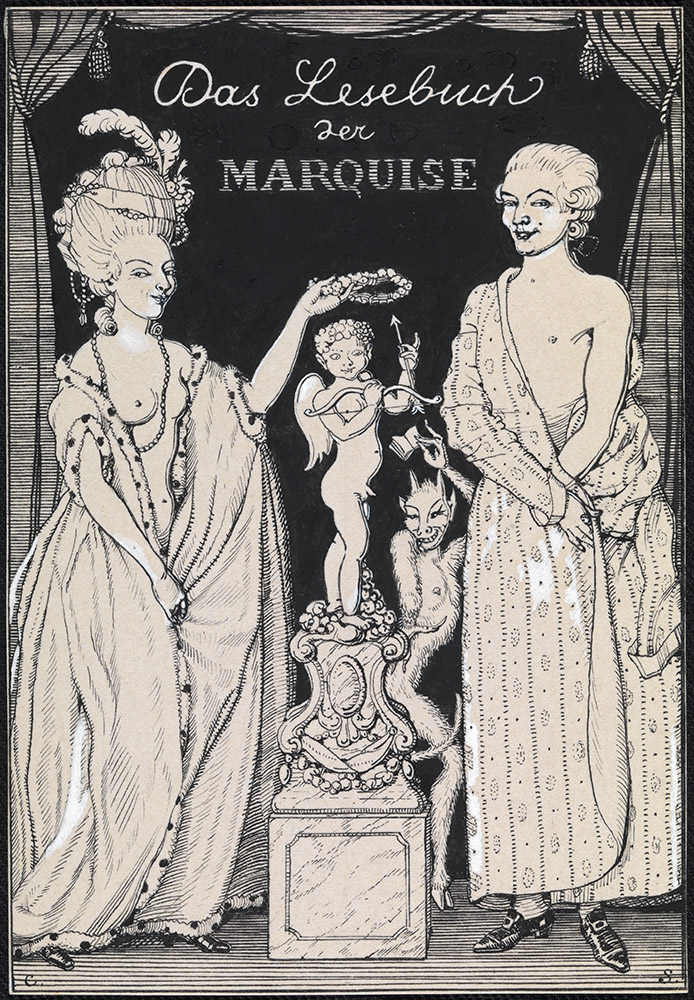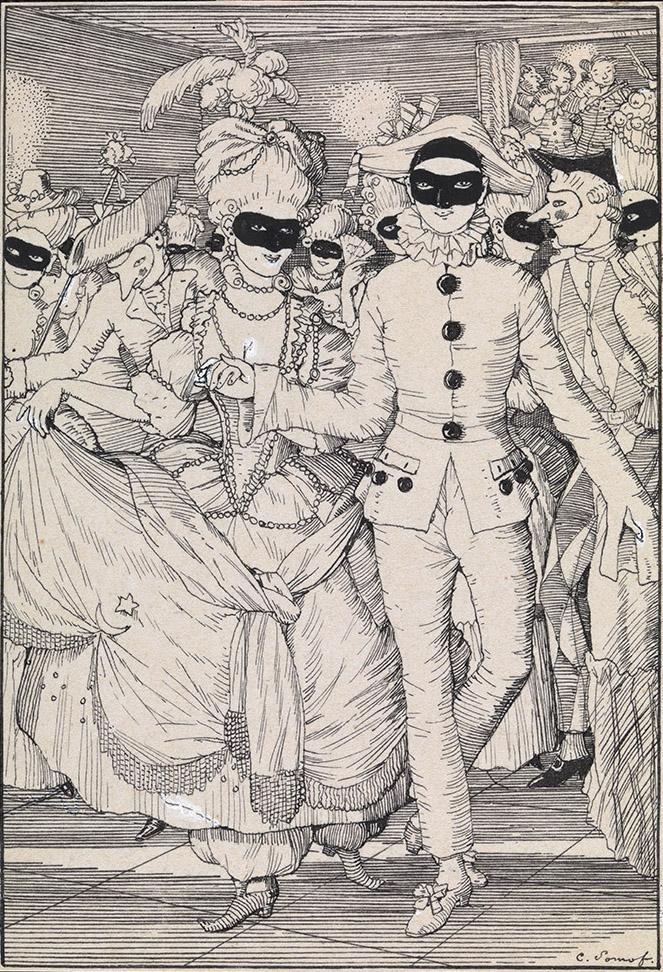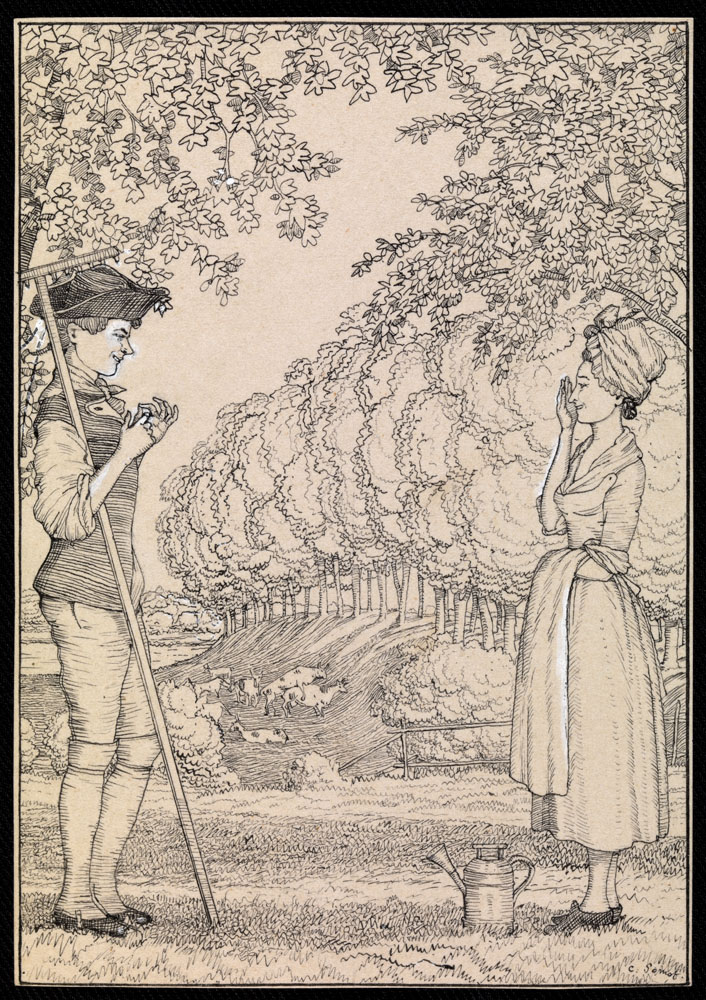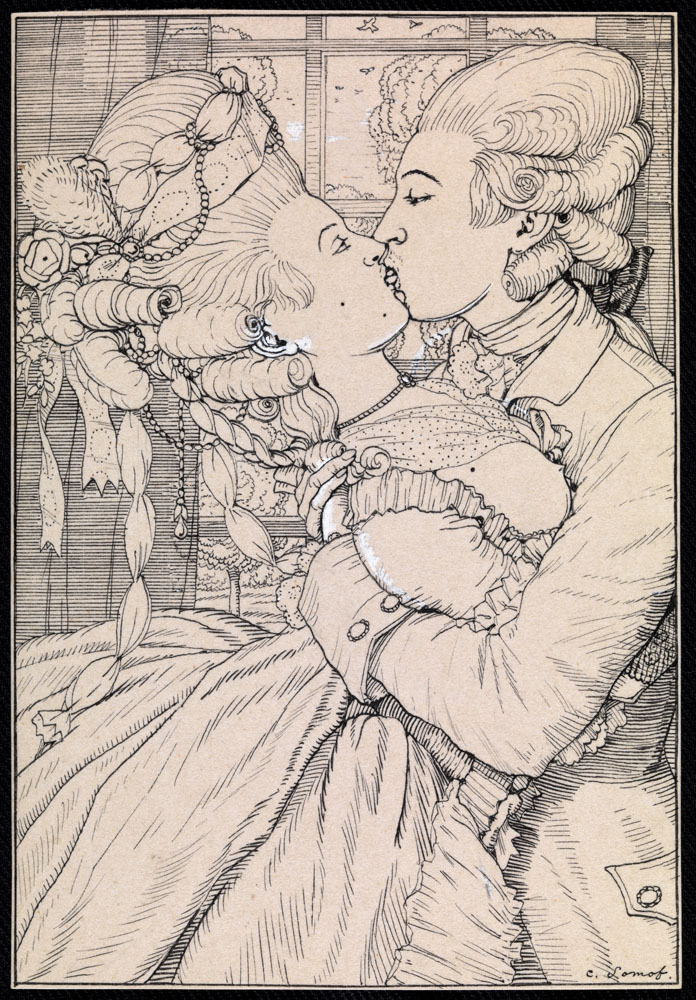MacDougall Auctions 28 November 2008
28 November 2008

* 6. SOMOV, CONSTANTINE 1869-1939
122 original ink drawings for Le Livre de la Marquise, (or Bol’shaia uncensored Marquise) Some signed in Cyrillic or Latin “K. Somov” or “C. Somof”, others signed with one or both initials in Cyrillic and Latin “K. S.”, “C. S.” or “S“ and some dated 1908, 1911, 1915, 1916, 1917 and 1919
Each black ink on paper and pencil in places, some heightened with white. Various sizes, the largest measuring 20.6 by 14.3 cm., and the smallest 0.7 by 0.9 cm.
1,500,000-3,000,000
Provenance: Private collection, USA.
For a full description of each drawing please refer to the Somov brochure.
Le Livre de la Marquise, a collection of 122 original ink drawings, are widely recognised as the
peak of Somov’s graphic art. Over the ten years that he worked on their creation,
Somov continually modified his compositions, sometimes producing more modest,
and sometimes more candid versions.
For example, some compositions are represented in this collection by two renditions.
The unobtrusive and elegant immodesty of eighteenth century French rococo
that stirred Somov throughout his life is deployed in the pictures of the Marquise
as an entire gallery, and typifies his work. When, after the first Diaghilev exhibition,
he had earned the nickname "Sodomov" the artist considered: "The essence of
everything is eroticism. Therefore art is unimaginable without an erotic basis." The
special feature of his artistic style is a refined elegance and beauty of motif, a playful
and sometimes forced eroticism, and the mechanical nature of the personages.
His flat, linear compositions are virtuosic and full of the most delicate ornamental
and decorative details. Although Somov did not look for a concrete historical setting,
his courtly scenes are played out in beautiful parks full of sculptures, neat
copses and trellises; elegant courting is accomplished on Louis XVI divans with
their curving backs, armrests and legs, near window frames, through which the
graceful outlines of shrubs and a cloudy sky can be seen, and screens decorated
with magnificent rococo bouquets. Variations on a single motif, of which Somov has so many, were more important to him than the choice of starting-point for these
variations.
His secret lies in the juxtaposition of openly decorative, stylishly curving figures
with a living nature, overflowing with colours and totally realistic interiors. An important
role in Somov’s graphic subjects is played by the symbol of the mask. It is
depicted both in headpieces and in one of the central illustrations, Masque. The
artist is attracted by the masquerade as a symbol of falsity and the marionette-like
nature of human feelings and actions. The ironic and almost gentle grotesqueness
of his love scenes are sometimes just as obvious as the deliberate embellishment of
the indecent.
In these studies Somov neither seeks to shock nor yearns for a past that
can never return. His forms, be they dresses, divans, screens, a slipper or the bare
arm of a beauty peeping out from under her clothes, seem in the fancifulness of
their lines almost akin to hieroglyphs. There is a vision of a fully modern life set in
an interior from the past.
There could be no better subject for the ingenious Marquise,
in which Somov, in the opinion of his contemporary, the leading art historian
and connoisseur of books, the academician A. A. Sidorov, "seemingly permitted himself
everything from which Russian art had abstained." Indeed, Somov’s drawings
were a genuine unsurpassed breakthrough in the Russian erotic genre. His talent and
the graceful elegance with which he embodied his piquant scurrilities are the real
reason why Le Grand Livre de la Marquise is valued so highly. It is a magnificent example
of a complete artistic project from the beginning of the twentieth century, realised
with total harmony of content and form. Summing up his impressions of the
edition that came out at the height of the Revolution, Sidorov wrote: "A book has
come out that, from the point of view of its typographical perfection, we can boldly
declare is the best work of polygraphic art to be published to date in Russia. We
mean Somov’s Livre de la Marquise... where the best of today’s graphic artists has
genuinely surpassed himself…".
Le Livre de la Marquise is an anthology of eighteenth century erotic French poetry
and prose, and contains 56 works by some 50 authors, including excerpts from works
by Voltaire, Parny, fragments from Les Liaisons Dangereuses by Choderlos de Laclos
and individual episodes from Casanova’s Memoirs. The cover has a representation
of a lady set in a light and graceful frame. The title of the book is given in French
on the lady’s luxuriant skirt. This is all the text there is: no publisher and no year.
The printing details are given on the title page in two colours: red and black. The
illustrations were generally intended for subsequent colouring, but some pictures
are in the form of silhouettes. Line drawings and silhouettes sometimes complement
each other. This applies in particular to the illustration "Chinoiseries", where the
silhouette of the marquise is placed in a decorative pen-drawn frame whose cartouches
contain everything imaginable: A Chinese mandarin with wide open hands
and impossibly long nails, a circus acrobat supporting himself on his head which is
resting on a vertical pole, numerous sharp-billed birds... Somov’s plan on this occasion
was to tie the illustrations closely to the text: the harmony of the printed page with the vignettes and tailpieces that decorate it is carefully
thought out. But at the same time they were without question valuable in their own
right and often existed in isolation from the book.
The book first saw the light of day in 1907, when it was published by Hans von
Weber in Munich (Das Lesebuch der Marquise). The idea behind its creation belonged
to the Austrian writer Franz Blei, who had compiled a small collection of erotic literature
of the ‘siécle galant’. It was the decision of von Weber, to invite Somov, who
was already well-known for his virtuoso pen and his taste for the courteous and elegant
world of the eighteenth century, to be the artist. The German censors only
permitted six illustrations and six vignettes out of the 31 drawings that Somov produced
for the book, and removed everything that seemed indecent. A total of 850
copies were printed, with a luxurious goat-skin binding, gold embossed and with
satin flyleaves. Moreover, the illustrations in the first 50 copies were coloured by
hand. The following year, 1908, a second edition of Le Livre de la Marquise was produced
in Leipzig, from the publishing house of J. J. Weber, and enjoyed great popularity.
But Somov was not satisfied with this edition as the illustrations did not
coincide with the text, the colour reproduction was unsuitable and the same vignettes
appeared several times.
It is not surprising therefore that eight years after the first edition, Somov returned
to the idea of the book; on 20 November 1915 he wrote in his diary: "Was at the
Union press at 5 o’clock for discussions with Grünberg, who had heard about my
desire to reprint Le Livre de la Marquise and had found me a publisher willing to allocate
me at least 5,000 for a private edition of 25 copies. This proposal is very
tempting". The work, which came to symbolise Somov’s output, continued into the
following years. There are many mentions of it in the artist’s diary. "Looked through
Parny, with the idea of including it in my book," he noted on 15 December 1915.
"Sat down to work this morning," Somov wrote on 2 January 1916. "Did two things,
and began doing lovers for a third time... Then began another composition, 'Pierrot
et la Marquise'. Drew all day until 10pm." He used various techniques, both watercoloured
line drawings and black and white silhouettes that typified his work. However,
the discussions with Grünberg came to nothing and Somov carried on adding
to his graphical suite, while delaying publication for a more suitable time, and with
great irony, it was the Russian Revolution that brought about a change. Censorship
was abolished in 1917, and gave Somov the opportunity of publishing a luxurious
edition of the book with bolder illustrations, and not in a private edition of 25 copies,
but on a suitable scale. One of the best printing houses in St Petersburg, R. Golike
& A. Vilborg & Company, undertook Le Livre de la Marquise, which had been re-compiled
and illustrated by Somov. However, while the luxurious volume was being prepared
for printing, the government began to clamp down; on 9 September
1918 Somov wrote in his diary: ‘Golike has been requisitioned, but Le Livre will appear
without any delay.’ In all, 800 copies were produced. The book was printed on
thick, hand-made paper, in a larger format than the German edition (268 x 203mm),
had a silk binding and contained 194 pages of text and 21 sheets of separate illustrations.
In addition, part of the run was printed in a special collectors’ version with
additional indecent illustrations which might even be described as pornographic.
Despite the abolition of censorship, for safety’s sake the place of publication was
given as Venice, although the book had been printed in St Petersburg, like the previous
one. This so-called Grand Livre de la Marquise is the rarest and most valuable of
all the versions of the book.
Bibliophiles began hunting for it literally as soon as it appeared. Le Grand Livre contained
illustrations from all the versions of the book that the artist had created up
to then: "particularly candid" subjects that were intended for the German edition,
but not included in it, a full set of pictures from the standard 1918 edition and additional
drawings that had been specially prepared.



Notes on symbols:
* Indicates 5% Import Duty Charge applies.
Ω Indicates 20% Import Duty Charge applies.
§ Indicates Artist's Resale Right applies.
† Indicates Standard VAT scheme applies, and the rate of 20% VAT will be charged on both hammer price and premium.